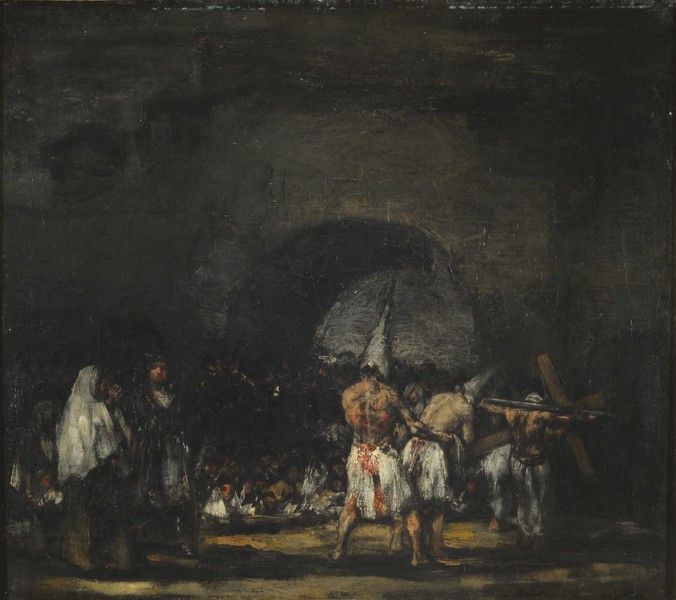- Cronología
- Ca. 1808
- Ubicación
- Buenos Aries National Museum of Fine Arts, Buenos Aires, Argentina
- Dimensiones
- 51 x 57 cm
- Técnica y soporte
- Oil on canvas
- Reconocimiento de la autoría de Goya
- Attributed work
- Titular
- National Museum of Fine Arts, Argentina
- Ficha: realización/revisión
- 28 Apr 2010 / 15 Jun 2023
- Inventario
- (2563)
The first information on these works was published by the Count de la Viñaza in 1887, who recorded them in the Madrid collection of Eustaquio López, which was sold in 1866. According to Juan Corradini (1965), in 1886 Miguel Cané, the Argentine ambassador to Spain, on the advice of the Duke of Alba, bought six paintings by Goya, including The Fire and War Scene, as well as Procession of Discipliners, commissioned by Gabriel Larsen del Castaño; Popular Feast, bought by Parmenio T. Piñero, and two paintings acquired by the Jockey Club of Buenos Aires.
In 1907, Popular Feast entered the Museum through the Piñero bequest. The remaining three were in the possession of the Ugarte family, who auctioned them in 1954, at which time doubts again arose as to their authorship. They were acquired by Horacio Acevedo with the intention of donating them to the MNBA, where they entered in 1958 by donation of his brothers Carlos Alberto, Arturo and Eduardo Acevedo.
The work seems to be another version of the work A Procession of Flagellants preserved in the San Fernando Academy. Here we are also presented with a group of flagellants, in this case walking next to the arch of a bridge, a common feature in various related works by Goya (see Masked Dance under an Arch). The two penitents wear the same dress as in the work belonging to the Academy, but this time they walk without pageantry or images, watched by the fervent onlookers. The modelling of the hardened bodies is magnificent, and the abundant rivulets of blood which run down their back gives the scene a solemn sense of drama. As well as the two flagellants there is a impaled figure and another who carries a heavy cross on his shoulders. The people gathered to watch the spectacle are grouped under the bridge. On the left, a veiled woman holds her hands to her face in a gesture of horror, while another woman by her side looks at the viewer, transmitting her rejection of the macabre religious spectacle, reminiscent of the horrified man in A Procession of Flagellants.
There is a copy of this work in the Lázaro Galdiano Museum in Madrid (inv. 2016), formerly attributed to Goya.
-
Paintings by Goya in the Buenos Aires MuseumThe Burlington MagazineLondon1965pp. 11-16
-
Vie et ouvre de Francisco de GoyaParísOffice du livre1970pp. 256, 267, cat. 974
-
BarcelonaPolígrafa1970vol. I, p. 373, cat. 679
-
L’opera pittorica completa di GoyaMilanRizzoli1974p. 130, cat. 602
-
Francisco de Goya, 4 vols.ZaragozaCaja de Ahorros de Zaragoza, Aragón y Rioja1980-1982vol. III, p. 188
